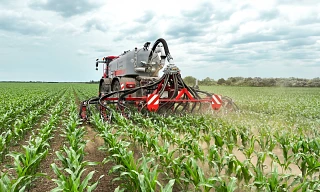Where movement must be guaranteed, high demands must be met under the adverse conditions in agriculture. Joints in agricultural machinery often require lubrication to ensure friction-free operation. The disadvantage: metal bushings are used in conventional applications, which require good lubrication. This requires large quantities of grease, which is delivered to the bearing via lubrication points. It is often not possible to seal the lubricated components properly so that harmful grease escapes. This is a particular problem in agriculture, as farmers should avoid environmental pollution from lubricants at all costs. "We were therefore looking for an application with low lubricant requirements for the SecatFlex SL," explains Andreas Erl, who was responsible for the development of the slurry hoe at Holmer Maschinenbau. From their existing contact with igus®, Erl and his team were quickly introduced to the special plain bearing iglidur® SG03 to their attention. "The SG03 kills two birds with one stone and is therefore so suitable for Holmer," says Thomas Weber, who supports Holmer as a technical sales consultant at igus®. Because like all iglidur® plain bearings, the SG03 is lubrication-free, as no external lubrication is required. At the same time, it offers a felt seal, which seals the bearing points against dirt and dust. This is a great advantage, especially in agriculture. The joints are often exposed to extreme loads and must offer a high degree of reliability. In laboratory tests, igus® has achieved a service life of up to 50 times longer for the plain bearing with felt seal compared to conventional solutions. In addition iglidur® SG03 impressed in the tests with its wear resistance.
The fact that Holmer Maschinenbau has once again chosen igus® components for the SecatFlex SL is due to the long-standing cooperation between the two companies. "We've actually always used igus® bushes," says Andreas Erl. In the meantime, the practical test has shown that Holmer has chosen the right solution. The first pre-series machine is on the road in Hungary, where an area of 1,000 hectares of maize is being fertilised.



